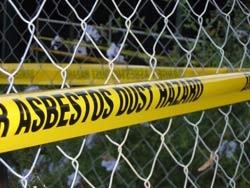 Meso warrior, Liz VanZandt of Oklahoma, is acutely aware of the recent devastation from the tornados in Moore, Oklahoma. “I watched as people were climbing through the rubble in search of loved ones, pets and personal items left behind from the tornado,” she said. As a mesothelioma survivor, her thoughts go immediately to the asbestos that the tornados released into the air. Natural disasters, like the tornados in Moore, disturb existing asbestos-containing materials and they become airborne. We know that any exposure to asbestos can lead to mesothelioma, so anyone present at the site of the tornados is at risk for developing mesothelioma.
Meso warrior, Liz VanZandt of Oklahoma, is acutely aware of the recent devastation from the tornados in Moore, Oklahoma. “I watched as people were climbing through the rubble in search of loved ones, pets and personal items left behind from the tornado,” she said. As a mesothelioma survivor, her thoughts go immediately to the asbestos that the tornados released into the air. Natural disasters, like the tornados in Moore, disturb existing asbestos-containing materials and they become airborne. We know that any exposure to asbestos can lead to mesothelioma, so anyone present at the site of the tornados is at risk for developing mesothelioma.
Ms. VanZandt knows this firsthand, saying “I wept when the thought came to my mind, long after they rebuild and the cameras are gone, the asbestos that they are in the midst of will most likely make some of them ill. It will be like getting hit all over.”
Unfortunately, these natural disasters and national tragedies (like the September 11th terrorists attacks) will continue to disturb the existing asbestos in our environment for years to come. The Environmental Protection Agency (EPA) estimates that asbestos still exists in 35 million homes in the United States, and that there are asbestos containing materials in most of the nation’s approximately 107,000 primary and secondary schools and 733,000 public and commercial buildings.[i]
The question remains, what will happen to the victims and first responders that are exposed to asbestos now, and develop mesothelioma 10-50 years down the road? The emergency funds provided by the Federal and State governments are not going to be available to them. ”I know the immediate needs have to be met and I am grateful this is being addressed. The long term needs should be acknowledged by our government.”
Unfortunately, even if asbestos were banned today, the existing threat remains. For all those who have been exposed in the past and will be exposed in the future, research to find better treatments and a cure for mesothelioma is the only way to ensure that asbestos becomes less dangerous and deadly.
[i] http://www.epa.gov/region4/air/asbestos/inform.htm Accessed May 30, 2013.





